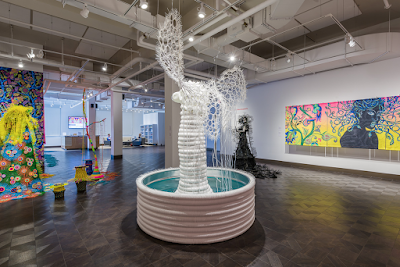The first element you experience in Heather Ujiie's
Terra Incognita is not its neon-bright colors or its variety of textures, but rather, the sound of running water. Echoing in the high-ceilinged Art Gallery at Rowan University, this steady low hum is part of "The Goddess," a white sculptural fountain placed in the center of the space, as if presiding over the technicolor splendor. Surrounding it, images of flora, fauna, humans and mythological beings all mingle in digitally-printed compositions that are both relentlessly cheerful and slightly on edge in their sheer dazzling brightness.
 |
| Heather Ujiie, Terra Incognita, Heather Ujiie, installation, Rowan University Art gallery. N.J. Fertility Figure: White fountain, PVC pipe, wire, white acrylic yarn, styro-foam swim noodles, duck tape, white tape, white paracord, thread, acrylic tubing, galvanized stainless steel basin, white Lucite disc, white acrylic crate, @ 96" high x 80" wide Photo credits: Hitoshi Ujiie |
Terra Incognita is a fragmented wonderland that addresses a range of weighty subjects as varied as ecological precarity, the nature of intimacy and the divine feminine, using imagery synthesized from the visual traditions of numerous world cultures. The colors of Mexican folk art meet the sinuously graceful figures of Persian manuscripts; a heightened sense of unreality inspired by Bosch's "The Garden of Earthly Delights" meets the minute detail of classical Indian painting. With its numerous visual delights,
Terra Incognita comes across as ambitious in intent if somewhat scattered in execution.
 |
| Demon, 84" high x 36" wide x 120", White tatooed hand painted mannequin, black embellished corset and wire hoop skirt, with black Zip Ties, sequins, and black lace Photo credits: Hitoshi Ujiie |
The most intriguing works are not the large printed canvases that adorn the walls and even cover the windows, but the multimedia sculptures, like "The Goddess" made of textiles and rubber, that draw upon traditional iconography of the sacred feminine. The counterpart to "The Goddess" is "Demon," a glittering black female mannequin created out of wire, boning, corset, tubing, and polyester lace. Clothed in intricate lacework and wiry tiered fabric, its head is engulfed in a bristling animal mask. The handicraft in these sculptural works is simply stunning and marvelously intricate; "Demon" in particular invites closer inspection, even as the plastic spines that emerge from the figure like porcupine quills work to repel you from getting too close.
 |
| Warrior, 84″ high x 36″ wide x 120″, Black Boning wire, Black vinyl screen mesh, multi color zip ties, multi-color felted circles |
"Warrior," a third sculptural work addressing the guises women have taken in myth and legend, fills up an entire corner of the gallery, its trippy-bright hues and plant stalk-like forms reminiscent of something out of a Doctor Seuss story. The strands of colorful rope that drip from its form are echoed in "Symbiosis," a digital print that takes up the rear wall of the space. Here, cords spill forth from the flatness of the image and trail onto the floor.
 |
| Matrix, 2018, 70″ high x 213″ wide, digitally printed on canvas polyester, with disperse dye heat transfer, quilted and embellished with sequins, paracord, and faux fur, printed at, Printed-Inc.com Photo Credits: Hitoshi Ujiie |
The most iconographically coherent of the printed murals, however, is "Matrix," embellished with sequins and fuschia faux fur, in which a female figure in profile is continually mirrored and repeated along a horizontal plane. Matrix, more than any of the more explicitly feminine works in
Terra Incognita, expresses Ujiie's interest in the "power and complexity of the female Voice." In "Matrix," each woman is not only her own self, but is a mirror image of the women around her, cascading outward from the center of the image in a lineage that reproduces itself throughout the ages.
The extensive explanatory text accompanying each piece in
Terra Incognita does little to clarify the aims of and intentions behind Ujiie's works, ultimately raising more questions than it answers. It's particularly unclear how the artist is attempting to link the earth and the capacities of real and mythic female bodies, and what purpose these linkages serve. Are we harkening back to the traditional association of femininity with nature, and of the destruction of the earth by artificial means with masculinity? Does the destruction of the earth amount to the desecration of women, and vice versa? If femininity is, in Ujiie's vision, one with nature, where does the purposeful artificiality of fashion and textiles, as viewed in "Demon," fit in?
"Demon" and "Goddess" might have swapped titles for a more unexpected juxtaposition of the double-edged nature of creation and destruction. While a black lace-clad "Goddess" might evoke a more occult visioning of female power, a white-winged "Demon" would turn the gentle trickle of the fountain into something far more sinister -- calling to mind the rising seas and earth's ability to both give and take.




Comments
Post a Comment